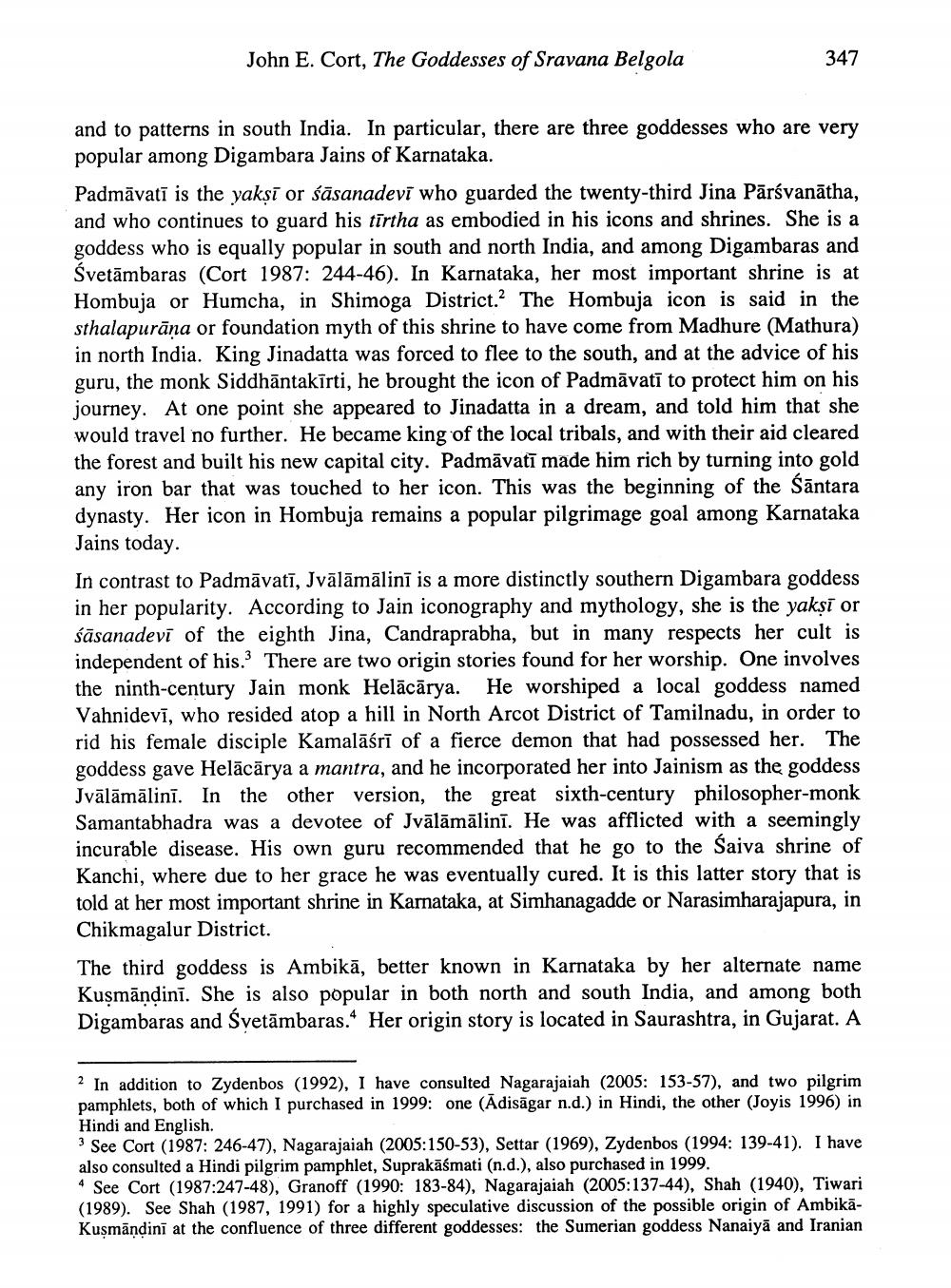________________
John E. Cort, The Goddesses of Sravana Belgola
347
and to patterns in south India. In particular, there are three goddesses who are very popular among Digambara Jains of Karnataka.
Padmavati is the yakṣi or śāsanadevi who guarded the twenty-third Jina Pārśvanatha, and who continues to guard his tirtha as embodied in his icons and shrines. She is a goddess who is equally popular in south and north India, and among Digambaras and Śvetāmbaras (Cort 1987: 244-46). In Karnataka, her most important shrine is at Hombuja or Humcha, in Shimoga District. The Hombuja icon is said in the sthalapurana or foundation myth of this shrine to have come from Madhure (Mathura) in north India. King Jinadatta was forced to flee to the south, and at the advice of his guru, the monk Siddhāntakīrti, he brought the icon of Padmavati to protect him on his journey. At one point she appeared to Jinadatta in a dream, and told him that she would travel no further. He became king of the local tribals, and with their aid cleared the forest and built his new capital city. Padmavati made him rich by turning into gold any iron bar that was touched to her icon. This was the beginning of the Santara dynasty. Her icon in Hombuja remains a popular pilgrimage goal among Karnataka Jains today.
In contrast to Padmavati, Jvālāmālinī is a more distinctly southern Digambara goddess in her popularity. According to Jain iconography and mythology, she is the yakṣi or sasanadevi of the eighth Jina, Candraprabha, but in many respects her cult is independent of his." There are two origin stories found for her worship. One involves the ninth-century Jain monk Helācārya. He worshiped a local goddess named Vahnidevi, who resided atop a hill in North Arcot District of Tamilnadu, in order to rid his female disciple Kamaläśrī of a fierce demon that had possessed her. The goddess gave Helācārya a mantra, and he incorporated her into Jainism as the goddess Jvālāmālinī. In the other version, the great sixth-century philosopher-monk Samantabhadra was a devotee of Jvälāmālinī. He was afflicted with a seemingly incurable disease. His own guru recommended that he go to the Saiva shrine of Kanchi, where due to her grace he was eventually cured. It is this latter story that is told at her most important shrine in Kamataka, at Simhanagadde or Narasimharajapura, in Chikmagalur District.
The third goddess is Ambikā, better known in Karnataka by her alternate name Kuṣmaṇḍini. She is also popular in both north and south India, and among both Digambaras and Śvetämbaras. Her origin story is located in Saurashtra, in Gujarat. A
2 In addition to Zydenbos (1992), I have consulted Nagarajaiah (2005: 153-57), and two pilgrim pamphlets, both of which I purchased in 1999: one (Adisägar n.d.) in Hindi, the other (Joyis 1996) in Hindi and English.
See Cort (1987: 246-47), Nagarajaiah (2005:150-53), Settar (1969), Zydenbos (1994: 139-41). I have also consulted a Hindi pilgrim pamphlet, Suprakāśmati (n.d.), also purchased in 1999.
See Cort (1987:247-48), Granoff (1990: 183-84), Nagarajaiah (2005:137-44), Shah (1940), Tiwari (1989). See Shah (1987, 1991) for a highly speculative discussion of the possible origin of AmbikäKuṣmaṇḍinī at the confluence of three different goddesses: the Sumerian goddess Nanaiya and Iranian




